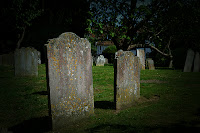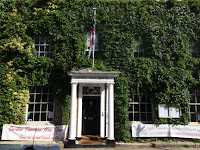The storybook charm of medieval Rye, belies a dark history that has given birth to many restless spirits. In fact, it’s meant to be one of the most haunted villages in England. As one of the Cinque Ports—a loose confederation of coastal towns in Kent and Sussex that allied for defense and trade—Rye became an instrumental cog in the economy of its time. This success also meant a greater deal of crime, and the town became a notorious haven for smugglers. These days, its narrow cobbled lanes are filled with coastal daytrippers and the squawk of seagulls. At least, until the sun goes down…
My home base while in Rye was the quite haunted Mermaid Inn, which has even been featured on programs such as Most Haunted. Dating to the 1420s (with cellars going back to the 1100s and with some Tudor upgrades in the 16th century), the Mermaid Inn is not only one of the oldest in England, it’s also among the most haunted. A woman clad in grey occasionally sits by the fireplace in Room 1. In Room 19, a man in splendid attire has been known to show himself. The apparition of a man has been seen walking through a bathroom wall into the main chamber of Room 10. 16th century duelers reenact their deadly swordplay in Room 16. Next door, in 17, the wife of a notorious smuggler named George Gray haunts a rocking chair. Guests awaken in an icy room to find it tipping back and forth.
Along Mermaid Street itself, the ghost of a little girl in a blue dress has been reported from time to time; while a small boy clad in—I kid you not—a sheet has been witnessed along Watchbell Street.
The unusually named Turkey Cock Lane is home to a spectral monk. The less than godly fellow was bricked up alive, so legend tells, after he was caught trying to elope with a local girl.
Rye Castle (aka Ypres Tower) was built around 1250 by Roger of Savoy as a defense against the French. Later it became the property of John d’ Ypres in 1430. The castle also served as a jail—one that many of the notorious smugglers of Rye no doubt became acquainted with. The ghosts of former inmates have been seen and investigations by paranormal investigators over the years have produced unusual recordings of disembodied voices.
Lamb House—Author Henry James (credited with the first modern ghost story, Turn of the Screw) stayed here in the late 1890s. He would later go on record that the ghost of an old woman helped him with his writing during his stay. Novelist E. F. Benson is claimed to have spotted a man dressed in a cloak vanish before his eyes while he sat in the home’s garden. One of the spirit’s, according to some accounts, is that of Allen Grebell, who had been murdered by a local butcher.
Gibbet’s Marsh, where this historic windmill rests, the reoccurring apparition of a man has been seen in the early morning hours as he walks across the fields toward the river before suddenly vanishing.
The sound of footsteps have stalked some as the moved through the empty confines of Needles Passage.
The Union Inn also dates back to the early 1400s and is thought by some to be haunted by a young girl. She’s mostly seen in the areas of the kitchen and dining room. The ghost of a young, unwed mother who died falling down the cellar stairs has been spotted as well.
The White Vine House (aka The Vine Hotel) saw some poltergeist activity in the mid 1990s. The kitchen would frequently be found in disarray and food moved or hidden. Reports of similar disturbances had occurred in the guest rooms as well.











